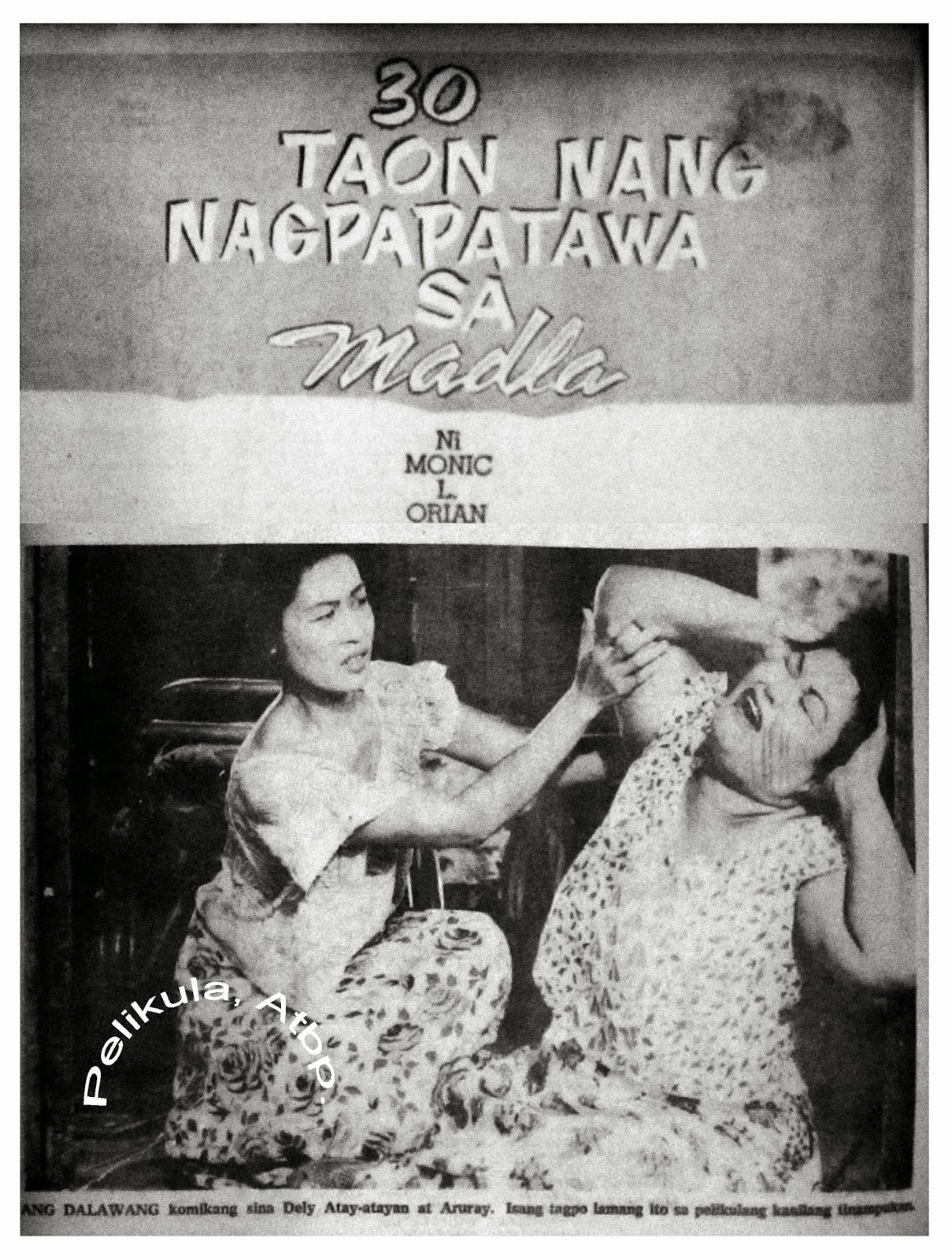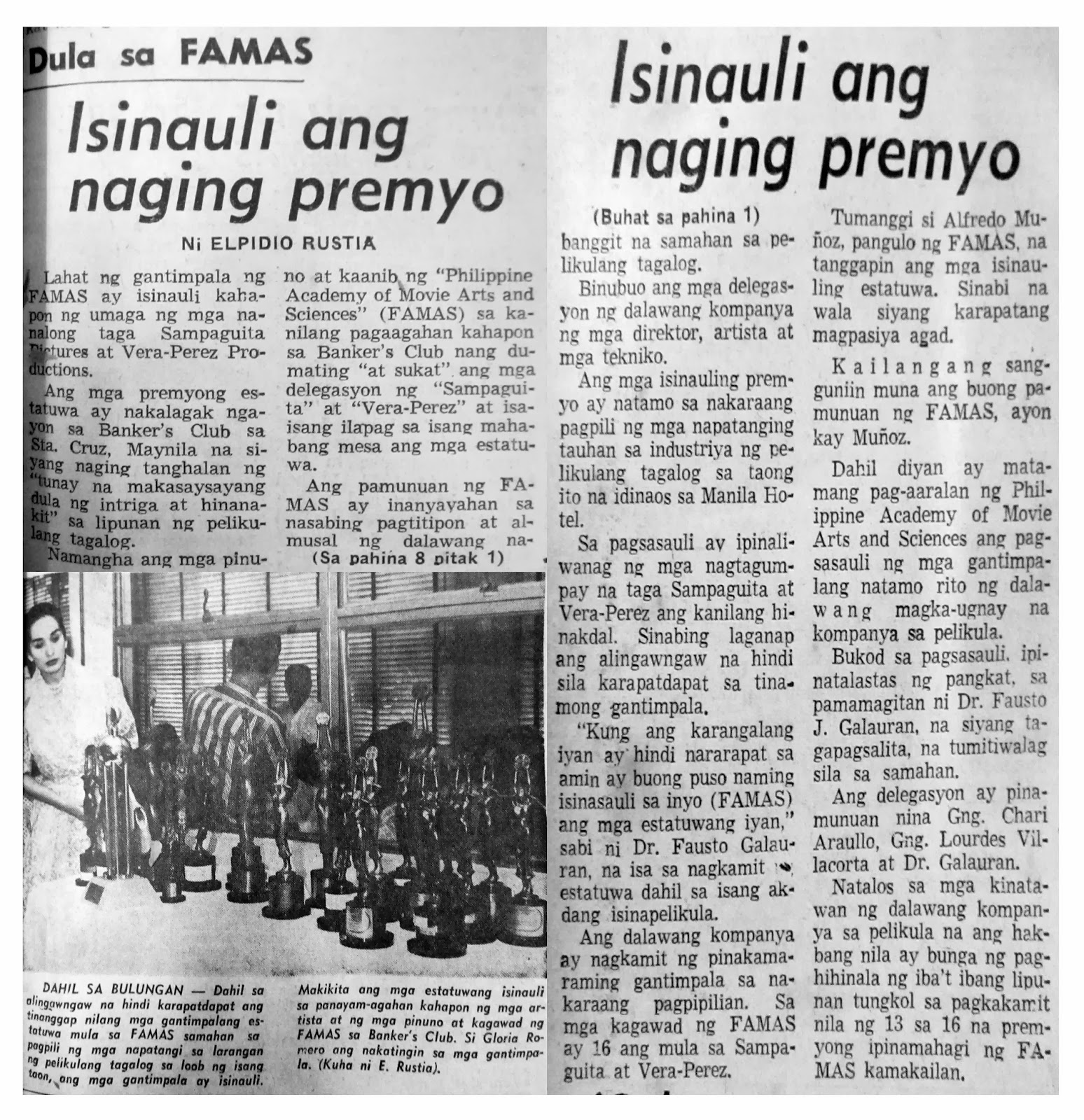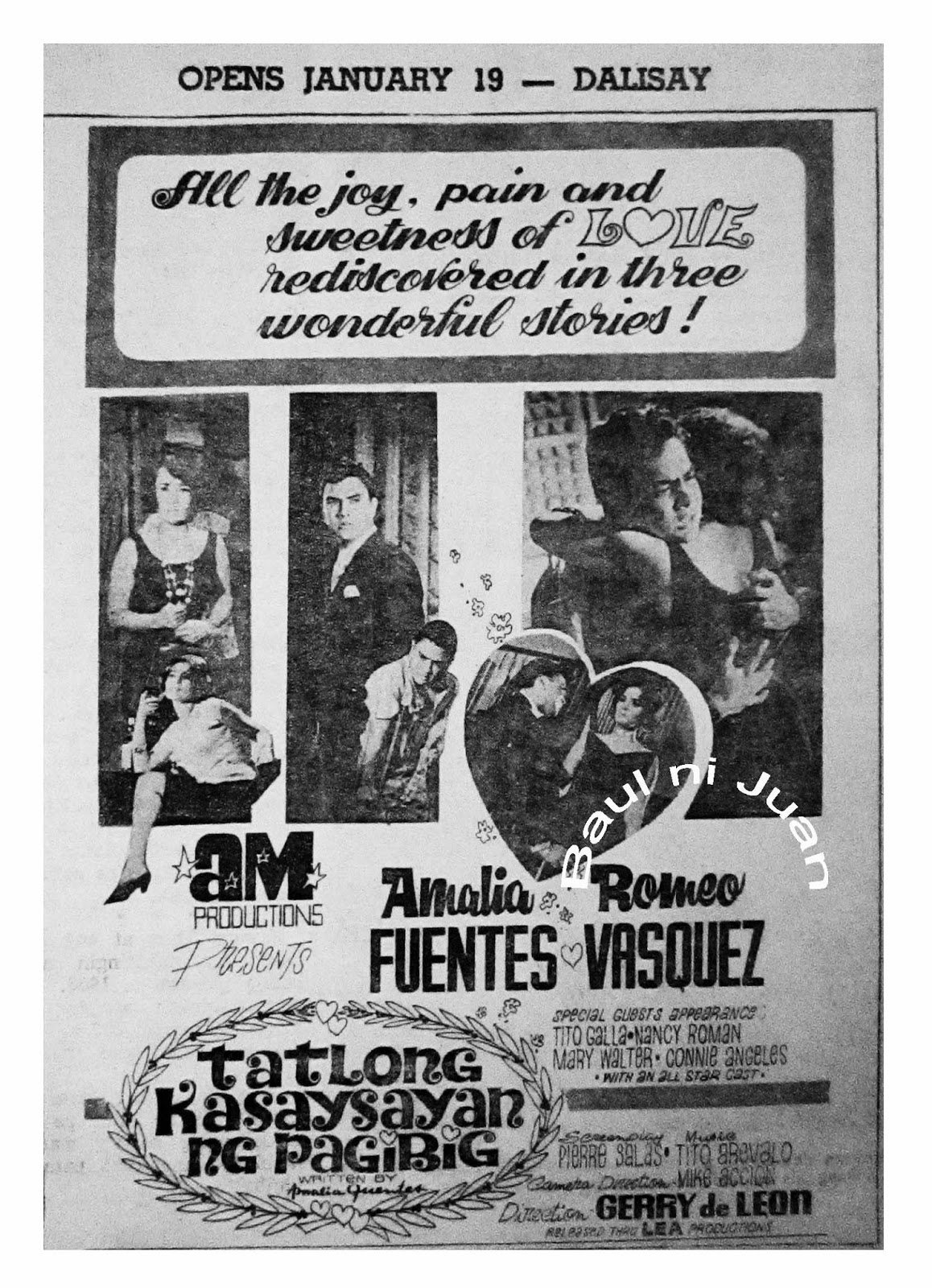Click on images to enlarge
Read the full article, below:
SO THE PUBLIC MAY KNOW. . .
. . . WHY SAMPAGUITA PICTURES QUIT THE FAMAS
In view of the statements in Lina Flor’s “Sparklers” in the Manila Times issue of March 15, 1960, referring to the calling of an “extraordinary meeting” as well as the suspension of the Constitution of the FAMAS (Filipino Academy of Movie Arts and Sciences), the automatic suspension of all memberships, and that the move were taken in “a sincere desire to make a stronger, better, and impregnable FAMAS,” (which meeting took place immediately after Sampaguita Pictures had been awarded thirteen (13) out of the sixteen (16) FAMAS awards for 1959), Sampaguita Pictures has been constrained to make known the following facts: --
(1) In 1952, when the FAMAS was organized, it extended an invitation to the various movie studios including Sampaguita Pictures, to participate in the annual grant of awards, which invitation Sampaguita accepted because it felt that the Academy and Sampaguita had one and the same aim – that of “fostering the growth and development of the motion picture art and industry in the Philippines.” People who worked for Sampaguita as well as people who worked for other studios were likewise extended invitations by the FAMAS for membership. Only the FAMAS makes the choice of whom to invite for membership the FAMAS always seeing to it that representation was equal among the three major studios of LVN, Premiere and Sampaguita.
Since 1952, this equal representation had been consistently followed. This year, the FAMAS again forwarded an invitation for members from Sampaguita as it did for members from other major studios. This equal membership from Sampaguita and the other major studios, LVN and Premiere, constitutes a minority of the large FAMAS body that makes the annual awards, the other members being from the press, radio, television and the independent movie companies, the whole body totaling ninety-eight (98) members this year.
(2) FAMAS nominates a certain number of pictures for the awards and requires that only such members as have reviewed a specified number of the pictures nominated, for a period of a month and a half are qualified to vote for the final awards. For this year, the FAMAS members from Sampaguita reviewed for the required period all the pictures nominated this year, thus qualifying to vote for the final awards. FAMAS members from LVN and Premiere, however, did not qualify for having failed to review the required number of pictures and therefore were disqualified to vote in the final awards. There were this year a total of seventy-two (72) FAMAS members from various representative groups that qualified to vote for the final awards. Out of this number, only twelve (12) were FAMAS members from Sampaguita. If members from LVN and Premiere were disqualified under FAMAS rules to vote, this is not the fault of Sampaguita.
(3) After the reviews, at a meeting held at the MCU Building for the purpose of making plans for the coming awards night, one member from among those disqualified moved that all studio members should inhibit themselves from voting in the final awards. Objection was made to this motion by some members on the ground that it was “out of order”, as members of the FAMAS who work with studios do not represent the studios but are all “FAMAS members”, in accordance with a resolution approved in a previous meeting held at the Del Rosario Bros. Hall. This notwithstanding, the FAMAS president, Mr. Alfredo Munoz, entertained the motion but tabled it for future action. He appointed a committee to meet the representatives of LVN, Premiere and Sampaguita. In the meeting between the FAMAS Committee and the representatives of the three major studios (LVN, Premiere, and Sampaguita) held at the NPC, the FAMAS president admitted, “I stand to be criticized, I knew the motion was out of order, but I accepted it indeference to the two movie producers (LVN and Premiere).”
(4) The FAMAS Committee reported to the FAMAS body that in their conference with the representative of LVN, Premiere , and Sampaguita these representatives of the three major studios declared that they would abide by whatever decision of the FAMAS body. In this same meeting, held at the MCU Building immediately before the FAMAS awards night, the FAMAS body ruled the same motion out of order.
(5) In spite of the declaration by the three major studios to abide by whatever decision the FAMAS body would make, and after the FAMAS body had ruled the motion out of order, one major studio pressed the controversy through Lina Flor’s “Sparklers” In the Manila Times, raising again the subject of participation in the final voting of FAMAS members and come from the movie studios. The controversy notwithstanding, the FAMAS body nevertheless met on March 4, 1960, at the Manila Hotel Fiesta Pavilion, to vote for the final awards. As we said, of the seventy-two (72) who voted, twelve (12) were members chosen by the FAMAS from Sampaguita and who under FAMAS rules were qualified to vote. Any way one looks at it, these twelve (12) out of seventy-two (72) could not in any way sway the majority in the choice of the final awards. As it came out however, the FAMAS body chose thirteen (13) out of the sixteen (16) FAMAS awards in favor of Sampaguita.
(6) This is not the first time that Sampaguita won several major and minor awards. It had consistently been receiving awards not only from the FAMAS but also from the Asian Film Festival. There were also times when LVN and Premiere won. All thee under the same rules of the FAMAS. As of this year nobody complained then of the rules or of the procedures. In fact, last year, the major awards were won by the Pacific Movie Productions, an independent studio without a single member with FAMAS. Sampaguita accepted the FAMAS decisions.
(7) The subject of participation by the major studios in the FAMAS was never brought up in any meeting of the Philippine Movie Producers’ Association. In the first place, Sampaguita believes that movie studios should not interfere with the actuations of the FAMAS. What is now claimed as a “stand” taken by LVN and Premiere was never formally declared, neither was Sampaguita advised officially or verbally about it. Because of this, Sampaguita was under the impression that the other studios would follow the accepted procedure and respect the decision of FAMAS. Sampaguita only came to know about the so-called “stand” after a statement was published in the newspapers and after the reviews were all over.
(8) When Sampaguita won these thirteen (13) awards, some dissatisfied quarters provoked discussion in newspaper columns. Though Sampaguita felt that one or two columnists must have been misinformed about the details of the FAMAS voting. It was not for Sampaguita but for FAMAS to enlighten them on the matter. It was expected that FAMAS would come out in defense of its own awards. That was the logical thing to do if FAMAS was above board. Instead, FAMAS chose to be silent. And when the controversy brought about by some dissatisfied quarters got out of hand, the “extraordinary meeting” was held, the FAMAS constitution suspended all members declared as having submitted courtesy resignations, previous members to be screened and passed before their memberships could be reactivated justifying these acts by a “desire to make a stronger, better and impregnable FAMAS” thus implying that the FAMAS constitution was a mere scrap of paper, that the association was weak, the integrity of its members questioned, that its actuations are not above-board and therefore that FAMAS was not “impregnable.”
Sampaguita Pictures feels that if it has to continue contributing to the healthy growth of the motion picture industry in the Philippines, it is now compelled to severe all its connections with FAMAS. Sampaguita has returned to FAMAS all the statuettes awarded to it during the past eight years.
BY:
(MRS.) DOLORES H. VERA
President
DR. JOSE P. PEREZ
Vice-President & General Manager
(MRS.) AZUCENA VERA PEREZ
Secretary-Treasurer
SAMPAGUITA PICTURES
AWARDS RETURNED BY SAMPAGUITA PICTURES, INC.
BEST COMEDY PICTURE
(1959) IPINAGBILI KAMI NG AMING TATAY
DOCUMENTARY
(1959) SUSAN ROCES AT THE PACIFIC FESTIVAL
SHORT FEATURE
(1957) ESPERANZA
5TH FILM FESTIVAL
(1958) AKO ANG MAYSALA
AWARDS RETURNED BY WINNERS HEADED BY DR. FAUSTO GALAURAN
DIRECTION
(1959) JOSE DE VILLA (KAMANDAG)
ACTOR
(1954) FRED MONTILLA (BONDYING)
(1957) VAN DE LEON (TAGA SA BATO)
(1959) VAN DE LEON (KAMANDAG)
ACTRESS
(1953) CARMEN ROSALES (INSPIRASIYON)
(1954) GLORIA ROMERO (DALAGANG ILOCANA)
(1956) LOLITA RODRIGUEZ (GILDA)
(1957) PARALUMAN (SINO ANG MAYSALA)
(1958) RITA GOMEZ (TALIPANDAS)
SUPPORTING ACTOR
(1958) PANCHITO ALBA (LUPANG KAYUMANGGI)
(1957) EDDIE GARCIA (TAGA SA BATO)
(1958) EDDIE GARCIA (CONDENADO
(1959) EDDIE GARCIA (TANIKALANG APOY)
SUPPORTING ACTRESS
(1953) KATY DE LA CRUZ (INSPIRASIYON)
(1956) ROSA MIA (TUMBADO CANA)
(1957) ETANG DISCHER (BUSABOS)
(1958) MARLENE DAUDEN (ANINO NI BATHALA)
(1959) MARLENE DAUDEN (KAMANDAG)
SCREENPLAY
(1959) DING DE JESUS (KAMANDAG)
CINEMATOGRAPHY
(1959) FELIPE SANTIAGO (KAMANDAG)
MUSICAL SCORING
(1959) CONSTANCIO DE GUZMAN (IKAW ANG AKING BUHAY
SOUND RECORDING
(1959) JOSEPH STRAIGHT (KAMANDAG)
FILM EDITING(1954) JOSE H. TARNATE (BONDYING)(1959) JOSE H. TARNATE (KAMANDAG)
MOVIE STORY(1956) DING DE JESUS (1957) DR. FAUSTO J. GALAURAN (SINO ANG MAYSALA?)
CIRIACO SANTIAGO MEMORIAL AWARD(1959) SUSAN ROCES (FOR OUTSTANDING ACHIEVEMENT IN 1959
. . . WHY ALL THE FAMAS WINNERS FROM 1952 TO 1959 RETURNED THEIR AWARDS TO THE FAMAS
More than the honor I felt in receiving the 1958 award for the “Best Supporting Actress” in “Tumbado Cana”, I looked to this statuette as a fitting legacy for my children.
I had hoped that in later years, they could point to this statuette with pride. But the FAMAS has destroyed this hope by its most recent act, and so I am returning my award.
(Sgd.) ROSA MIA
As an actress, I have always dreamed of winning a FAMAS award, but I didn’t content myself to merely dreaming.
I worked hard and tried in every way to improve myself professionally, so when I was chosen the Best Supporting Actress of 1958 for “Anino Ni Bathala” and then again in 1959 for “Kamandag”, I accepted the statuettes with pride and a feeling of merited accomplishment for I did not know then, that the FAMAS was not sure of their decisions.
So with due respect, I wish to return these awards.
(Sgd.) MARLENE DAUDEN
Malaking karangalan ko na napabilang sa mga tumanggap ng FAMAS award sa “Best Photography” ng “Kamandag”, subali’t nang malaman ko ang huling pasiya ng Pamunuan ng FAMAS ay minarapat kong isauli ang nasabing award, sapagka’t ang isang tagumpay na nababalutan ng alinlangan ay isang tagumpay na walang halaga.
(Sgd.) FELIPE SANTIAGO
The tears I could not help in my pride on receiving my statuette in 1958 for Best Actress in “Talipandas”, is a memory I recollect with shame whenever I am reminded it was given by the FAMAS in a ceremony it now renounces as a mistake. I received it knowing I gained it through years of hard work and conscientious dedication to my art. The FAMAS obviously does not think it so. It is with relief that I return my statuette.
(Sgd.) RITA GOMEZ
It was with great honor and pride that I accepted the Ciriaco Memorial Award for Outstanding Achievement in 1959 given through the FAMAS which I hold in high esteem.
I treasured this award, but now that the FAMAS itself has depreciated its value, I feel that I have no alternative but to return it, for it has been rendered worthless by the very same organization that awarded it. I would like to stress, however, that my action should not be construed as intending to hurt the donor, Mrs. Santiago, whom I believe donated it with the best of intentions. For this, I wish to thank her from the bottom of my heart.
(Sgd.) SUSAN ROCES
It was with great joy that I received each of my three awards for best supporting actor 1957, “Taga Sa Bato,” 1958, “Condenado,” 1959, “Tanikalang Apoy,” believing that I deserve and merited each of them. But recent developments that point to the fact that I received the said awards before the FAMAS had decided to make of itself an “impregnable organization, beyond and above suspicion.” I feel that I cannot keep these statuettes, for to me, they have ceased to be symbols of honor.
(Sgd.) EDDIE GARCIA
When I received my award for best actress in 1954, for “Dalagang Ilocana,” I was deeply honored and grateful for the recognition granted me. But what the FAMAS has recently done makes me ashamed to keep this award, or even the memory of it. So I have no alternative but to return this award, that I may still keep my dignity and self-respect.
(Sgd.) GLORIA ROMERO
Buong puso at karangalan kong tinanggap ang “Award” na “Best Musical Composer” sa taong 1959 para sa pelikulang “Ikaw Ang Aking Buhay” sa pagaakala kong ang pasiya ng Famas ay nababatay sa kalinisan ng budhi ng mga kasapi. Ito pala ay isang pagkakamali kaya ako ay tumitiwalag na, bilang kasapi ng Famas at isinasauli ko na rin ng walang pag-aalinlangan ang karangalang iginawad nila sa akin.
(Sgd.) CONSTANCIO DE GUZMAN
I shed tears of misery and bitterness for the woman I portrayed in “Inspirasiyon.” When I got the best actress award for my performance in this picture in 1953, I shed tears of joy and fulfillment. But again I cried for the passing away of the Famas whose constitution it has suspended the very constitution that has governed the body from the very beginning, thereby implying that the award I received was a mistake.
(Sgd.) CARMEN ROSALES
Isinasauli ko ang aking Award sapagka’t ayaw kong magkamit ng honor dahil sa pagkakamali ng FAMAS ng tagurian nila akong pinakamahusay na karakter actor nuong taong 1955 sa pelikulang “Lupang Kayumanggi.”
(Sgd.) PANCHITO ALBA
I was once proud to serve as a member of the FAMAS.
But due to recent events and developments and due to certain rash decisions and arbitrary acts of certain groups in the Academy who can not but kowtow to outside pressure groups, thereby discrediting the FAMAS as a whole, I hereby tender my resignation as a member of the said ACADEMY.
Together with this resignation, I hereby return the FAMAS trophy which I won as “BEST LEADING ACTOR” for 1954 for “Bondying.”
The recent action of the FAMAS to reorganize and screen all its members to make the ACADEMY “IMPREGNABLE, implies that the body before was pregnable and without integrity, thereby tacitly admitting that ALL the AWARDS the Academy has given since its inception are all valueless.
(Sgd.) FRED MONTILLA
I have won three awads – two for the “best screen-plays” (Sampaguita & Premiere). One for “Best” story (Premiere). I have always believed to merit them. I have always believed in the FAMAS but a recent meeting with the intention of making the Famas a bigger, a better and impregnable organization has given me some doubts – does this mean then that the FAMAS in the past was not big, not the best and not impregnable? And so with hurt pride, I am returning my awards.
(Sgd.) DING DE JESUS
When I first won my award in 1954, for best film eding in “Bondying,” I felt I was the proudest father of all because I believe I gave my children something to keep for posterity to inspire them and make them proud of their father.
I therefore struggled more through sweat and untold sacrifices to win another one and maybe more till finally I achieved it again in 1959 for “Kamandag,” but by the recent turn of events where the FAMAS has impliedly made me feel that the awards were mistakes, I feel I can no longer hold on to my awards with honor and dignity.
(Sgd.) JOSE H. TERNATE
I’m returning my award for best actress in “Gilda” because I’ve found out that when the FAMAS gave it to me in 1956, it might have been a mistake.
(Sgd.) LOLITA RODRIGUEZ
In the last two years, I have always believed that my FAMAS award for Best Actress, 1957, “Sino Ang Maysala?,” is priceless, but it seems the recent situations of the FAMAS Body have made this award worthless, so I am returning it, along with my membership card.
(Sgd.) PARALUMAN
I have been out of the movies for quite sometime now, but it does not mean my interest in the local movies has ended.
When I read from the “SPARKLERS” that the FAMAS had suspended the constitution that had been governing it for the eight years of its existence, I believe that the FAMAS seems to admit that all the awards it has been giving since it was founded are products of big mistakes and therefore not worth keeping.
For this reason, I have the honor to return this statuette, awarded to me in 1953 for my performance in “INSPIRASIYON.”
(Sgd.) KATY DE LA CRUZ
Because of the drastic move taken recently by the FAMAS in its “extraordinary meeting” where it rendered its constitution a mere scrap of paper by suspending it,” I returned the statuette awarded to me for 1959 Best Sound Recording in KAMANDAG – with hurt pride but untainted dignity.
(Sgd.) JOSEPH STRAIGHT
Ref.: Taliba (Tagalog Newspaper), March 9, 1960)
* * * * * *
.jpg)

_p1.jpg)
_p2.jpg)
_p1.jpg)
_p2.jpg)
_p3.jpg)
_p4.jpg)
_p5.jpg)
.jpg)
.jpg)
.jpg)
_p1.jpg)
_p2+copy.jpg)
_p3.jpg)
.jpg)
+Historical+Epic+(Weekly+Nation,+April+21,+1969).jpg)
+Isinauli+Ang+Naging+Premyo+(Taliba,+March+9,+1960).jpg)
.jpg)

.jpg)
.jpg)
.jpg)
a.jpg)
.jpg)
.jpg)
.jpg)
.jpg)
a.jpg)
a.jpg)
b.jpg)
c.jpg)
d.jpg)
e.jpg)
f.jpg)
.jpg)
b.jpg)
.jpg)
a.jpg)









.jpg)
a.jpg)
.jpg)







d.jpg)
c.jpg)
.jpg)

a.jpg)
b.jpg)
.jpg)
.jpg)
.jpg)
.jpg)
+with+Mayor+Villegas.jpg)
_p1.jpg)
_p2.jpg)
b.jpg)










